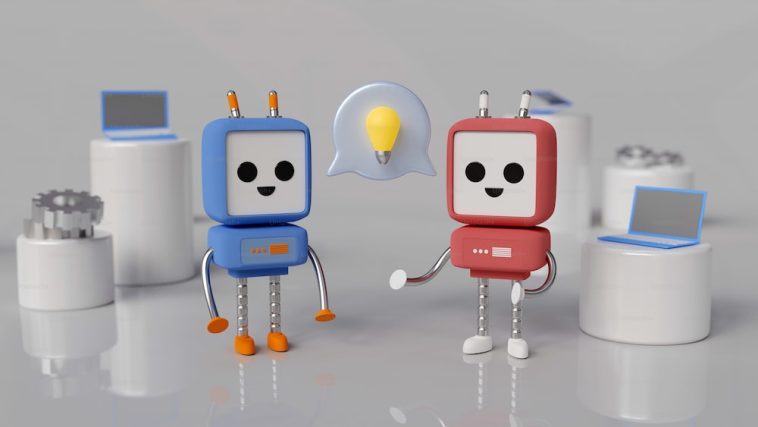Introduction.
Welcome to the exciting world of chatbot creation! Chatbots have become a ubiquitous presence in our daily lives, enhancing customer support, streamlining business processes, and even adding a touch of interactivity to our favorite websites and applications.
If you’ve ever wondered how to make your own chatbot, you’re in the right place.
Building a chatbot might sound like a daunting task, reserved for tech-savvy programmers or AI experts.
However, with the advancements in technology and the availability of user-friendly tools and platforms, creating your own chatbot has never been more accessible.
In this guide, we’ll walk you through the step-by-step process of making your own chatbot, from defining its purpose and designing its personality to choosing the right development platform and implementing AI capabilities.
Whether you’re a seasoned developer or a complete beginner, this guide will equip you with the knowledge and tools to bring your chatbot vision to life.
So, if you’re ready to embark on an exciting journey of AI-driven conversations and create a virtual assistant or interactive companion of your own, let’s get started on how to make your own chatbot!
What Is a Chatbot?
A chatbot is an artificial intelligence (AI) program designed to interact with users through conversation, typically in a text-based format.
It is a software application that uses natural language processing (NLP) techniques to understand and interpret user inputs and provide appropriate responses.
Chatbots can be found on various platforms, such as websites, messaging apps, or virtual assistants.
Chatbots can be classified into two main types: rule-based and AI-powered. Rule-based chatbots follow predefined rules and patterns to respond to user queries.
They rely on a set of if-then statements or decision trees to guide the conversation. On the other hand, AI-powered chatbots utilize machine learning and NLP algorithms to understand and generate human-like responses.
These chatbots learn from vast amounts of data and improve their performance over time. The capabilities of chatbots vary depending on their design and purpose.
Some chatbots are programmed to handle specific tasks or provide information on a particular topic, while others are designed for more complex and interactive conversations.
What are The Benefits of Chatbots for My Business?
One such solution that has gained significant popularity is the implementation of chatbots. These AI-powered conversational agents offer numerous benefits to businesses across various industries.
In this article, we will explore the advantages of chatbots and how they can revolutionize your business operations.
1. Enhanced Customer Support.
Chatbots provide businesses with an efficient and scalable solution for customer support. They can handle a wide range of inquiries and provide instant responses, ensuring customers receive prompt assistance around the clock.
Chatbots can answer frequently asked questions, guide users through processes, and even resolve common issues.
By reducing response times and improving accessibility, chatbots significantly enhance customer satisfaction and loyalty.
2. Cost and Time Savings.
Implementing chatbots can lead to substantial cost and time savings for businesses. Unlike human agents, chatbots can handle multiple customer inquiries simultaneously without experiencing fatigue.
This scalability allows businesses to serve more customers efficiently, reducing the need for extensive customer support teams.
Additionally, chatbots operate 24/7, eliminating the constraints of traditional working hours and reducing labour costs associated with staffing customer service personnel around the clock.
3. Increased Efficiency and Productivity.
By automating repetitive and mundane tasks, chatbots free up human resources to focus on more complex and value-added activities.
Chatbots can handle tasks such as order tracking, appointment scheduling, and information retrieval, reducing the workload on employees.
This increased efficiency translates into improved productivity and allows businesses to allocate human resources to areas that require specialized skills or personal attention.
4. Personalized Interactions and Recommendations.
AI-powered chatbots can analyze customer data and preferences, enabling them to deliver personalized interactions and recommendations.
By understanding user behaviour, chatbots can provide tailored suggestions, product recommendations, or targeted promotions.
This personalized approach enhances the customer experience, fosters engagement, and increases the likelihood of conversions and repeat business.
5. Data Collection and Analytics.
Chatbots act as valuable data collection tools for businesses. Through conversations with customers, chatbots gather valuable insights into customer preferences, pain points, and behaviour patterns.
This data can be analyzed to identify trends, understand customer needs, and make data-driven business decisions.
Chatbot analytics provide businesses with a deep understanding of customer interactions, allowing them to refine their strategies and optimize their offerings.
6. Improved Lead Generation and Sales.
Chatbots can play a crucial role in lead generation and sales. By engaging with website visitors or app users, chatbots can initiate conversations, capture leads, and guide potential customers through the sales funnel.
They can provide product information, assist in product selection, and even facilitate transactions. With their ability to provide instant responses and personalized recommendations, chatbots contribute to higher conversion rates and increased sales revenue.
7. Seamless Integration with Multiple Channels.
Chatbots can seamlessly integrate with various communication channels, including websites, messaging apps, social media platforms, and even voice assistants.
This versatility allows businesses to meet customers wherever they prefer to engage, providing a consistent and unified experience across channels.
Whether customers reach out through a website chat widget or a messaging app, chatbots can offer the same level of support and information, ensuring a cohesive brand experience.
8. Quick and Accurate Information Retrieval.
Chatbots can access vast amounts of information and retrieve it instantly. This capability enables them to provide accurate and up-to-date information to customers in real-time.
Whether it’s details about product specifications, pricing, or order status, chatbots can retrieve the information quickly and efficiently.
This not only saves time for customers but also ensures they receive accurate and consistent information, reducing the chances of misunderstandings or errors.
9. Language Support and Global Reach.
With the power of natural language processing, chatbots can communicate in multiple languages, catering to customers from different regions and demographics.
This language support enables businesses to expand their reach and engage with a global customer base.
Chatbots can overcome language barriers, ensuring effective communication and support for customers worldwide.
By providing localized experiences, businesses can foster stronger connections and build trust with their international customers.
10. Continuous Learning and Improvement.
AI-powered chatbots can learn and improve over time. Through machine learning algorithms, chatbots can analyze customer interactions, identify patterns, and continuously refine their responses and capabilities.
This means that the more customers engage with the chatbot, the smarter and more accurate it becomes.
Chatbots can adapt to evolving customer needs and preferences, ensuring that they provide the most relevant and helpful information and support.
How Do I Make My Chatbot?
Chatbots have become an integral part of our digital landscape, transforming the way we interact with businesses, websites, and even virtual worlds.
If you’ve ever been intrigued by the idea of having your own AI-powered conversational agent, you’re in luck!
Creating a chatbot is now more accessible than ever, thanks to the abundance of user-friendly tools and platforms available.
In this article, we’ll take you through the step-by-step process of making your own chatbot, regardless of your technical background or experience.
Step 1: Define the Purpose and Scope.
Before diving into the technical aspects, it’s crucial to define the purpose of your chatbot. Determine what you want your chatbot to achieve.
Is it intended for customer support, lead generation, providing information, or just for fun interactions? Understanding the purpose will guide the design and development process.
Step 2: Choose the Development Platform.
Once you have a clear purpose in mind, choose the right development platform for your chatbot. There are numerous options available, ranging from user-friendly, no-code platforms to more advanced, developer-oriented frameworks.
Some popular choices include Dialogflow, Microsoft Bot Framework, Chatfuel, and ManyChat. Select the one that best aligns with your technical expertise and requirements.
Step 3: Design the Chatbot’s Personality.
The personality of your chatbot plays a crucial role in how users perceive and interact with it. Determine the tone, language, and overall personality that best suits your chatbot’s purpose.
A friendly, approachable tone might be suitable for customer support, while a playful and creative tone could work well for a chatbot aimed at entertainment.
Step 4: Map Out the Conversation Flow.
Create a conversation flowchart to outline the various interactions users will have with your chatbot. Consider the different scenarios and responses your chatbot should provide based on user inputs.
A well-designed conversation flow will ensure that the chatbot can handle a variety of user queries effectively.
Step 5: Implement Natural Language Processing (NLP).
To make your chatbot truly conversational, implement natural language processing (NLP) capabilities.
NLP enables the chatbot to understand and interpret user inputs more accurately, making the interactions feel more human-like. Most chatbot development platforms offer built-in NLP functionality.
Step 6: Train Your Chatbot.
Once the conversation flow and NLP are in place, it’s time to train your chatbot. This involves feeding it with a diverse range of sample conversations to improve its understanding and responses.
As you train the chatbot, review its performance and make adjustments as needed to ensure it aligns with your desired outcomes.
Step 7: Test and Iterate.
Before deploying your chatbot, conduct thorough testing to ensure that it functions as intended. Test various user scenarios and gather feedback from real users to identify any issues or areas for improvement. Iteratively refine your chatbot based on the feedback received.
Step 8: Deploy Your Chatbot.
With the testing phase complete, it’s time to deploy your chatbot to the desired platform or channels.
Whether it’s on your website, social media platforms, or messaging apps, ensure that the deployment process is seamless and user-friendly.
Step 9: Monitor and Improve.
After deployment, monitor your chatbot’s performance and user interactions regularly. Use analytics and user feedback to identify patterns, understand user preferences, and continuously improve your chatbot’s capabilities.
Conclusion.
Making your own chatbot has never been more accessible or exciting. With the abundance of tools and platforms available, you can create AI-powered conversations that engage and delight users, regardless of your technical expertise.
Whether you’re a business owner looking to enhance customer support or an enthusiast eager to explore the world of conversational AI, the steps outlined in this guide will help you bring your chatbot vision to life.
Embrace the world of chatbot development and start crafting meaningful and interactive experiences through AI-powered conversations.
The possibilities are endless, and your chatbot is only limited by your imagination! Happy chatbot building!






GIPHY App Key not set. Please check settings